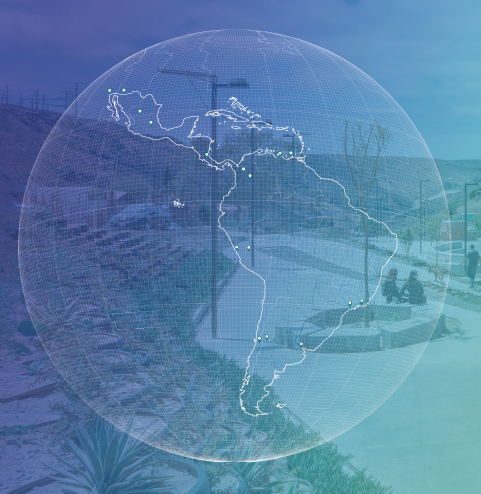The environmental crisis accentuates inequality. In Latin America and the Caribbean, the most vulnerable populations often reside in informal, precarious, or popular settlements, which are more exposed to climate events and generally have less access to infrastructure and ecosystem services. In recent years, designers and urbanists have offered important insights into rethinking informal settlements and developing strategies to improve their inhabitants’ quality of life, safety, and opportunities. Today, it is essential to incorporate climate criteria into urban interventions effectively.
The generation of permeable surfaces in places like parks or the rooftops of buildings can contribute to the increasing of infiltration, decreasing the impacts of floods, reducing landslides, managing and cleaning water, and increasing availability of water for domestic use, in this way reducing the risk of flooding as well as shortages and poor quality of water. They can also reduce the heat island effect, increase biodiversity, produce edible food, provide recreational spaces. Green infrastructure and nature-based solutions offer multiple benefits, are relatively low-cost, use common technologies and materials. Yet, they are rarely implemented in the most vulnerable communities. Green areas in general are a rear commodity. Looking at some of the important cities in Latin America – Sao Paulo, Santiago de Chile, Buenos Aires, Medellin, Bogota – one can see how the areas of lower income are the ones that have less access to public space and urban green areas. Public space plays a fundamental role as a platform for civic action, exchange, and empowerment. Combined with green infrastructure, it can become a medium through which to improve social and environmental resilience in the vulnerable neighborhoods.
Ecological Design. Strategies for the Vulnerable City is a project and a series of books published by the Inter-american Development Bank. The main goal is to measures the impacts of the climate crisis in the most vulnerable areas of Latin America and the Caribbeans- the informal city – while reflecting on how to protect those who are most strongly affected by the consequences of climate change. Through 30 case studies of landscape and urban design, the book provides new lenses to analyze risk and design nature-based solutions in precarious, informal, popular, vulnerable urban settlements, to make the informal city a more resilient city in the face of the climatic pressures that will come in the coming decades. These projects are presented as a three-fold objective to create synergies between widespread, multipurpose, low-cost, low-consumption, interventions that can make cities more resilient for all, starting from the margins, starting from public space, starting from nature:
- Restore and Upgrade: use nature-based solutions to repare the damage caused by climate events, such as storms or land-slides, or to respond to conditions of extreme risk, and at the same time take the opportunity to improve the neighborhood. And viceversa, every intervention to improve public space should include an estimate of the present and future climate risks and help prevent them.
- Adapt and connect: for cities to adapt to climate change, it is necessary to establish a structural change and more ambitious projects that go beyond specific neighborhoods: increasing permeable surfaces, improving drainage systems, ensuring access to water, protecting biodiversity, etc, require a systemic integrated effort. Improving the quality of life in informal neighborhoods in the long-term also implies a systemic integrated effort, improving accessibility and connection to urban services and opportunities.
- Anticipate and mitigate: Similarly, mitigation strategies imply imagining new ecologies, economies, and cultural changes to anticipate future conditions. In this way, it is important to think of the most vulnerable settlements and neighborhoods as a developing reality, anticipating transformations and mitigating eventual risks.
Download the books here:
J. Sordi, F. Vera, Ecological Design. Strategies for the Vulnerable City (IaDB, 2021)
F. Vera, J Doherty-Bigara, S. Patiño, J. Sordi. Ecological Design II. Green Infrastructure and Public Space in Latin America and the Caribbeans (IaDB, 2022).

– Ecological Design. Strategies for the Vulnerable City Exhibition, C40 Mayor’s Summit 2022, Buenos Aires. Curators: Felipe Vera, Jeannette Sordi, Santiago Mota, Soledad Patiño, Stefano Romagnoli, Maria Camila Uribe, et al.

